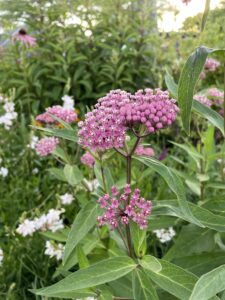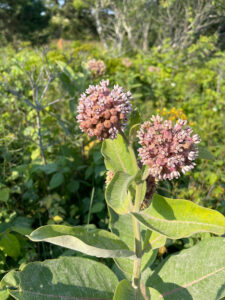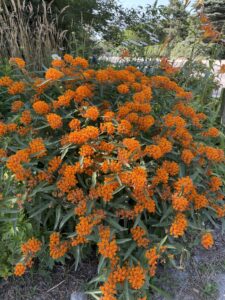There are many reasons to plant a garden: to add beauty to your surroundings, grow food or medicines, add value to your home, etc. In recent years, islanders have become more and more interested in gardening to support our native ecosystem by providing shelter and food for native fauna. Butterflies are always at the top of the list of insects that gardeners would like to support. Many are amazingly beautiful, but also in real need of our help as their habitat is ever-shrinking due to human activities like development and farming.
Loads of native plants are a food or nectar source for caterpillars and butterflies, but we get the most questions about milkweed this time of year. There are several species of milkweed that are native to the northeast, with more cultivated varieties in the trade as well. We love these plants because they are easy to grow in full sun with average garden conditions. The most popular of these is butterflyweed, Asclepias tuberosa, but we also stock others.
All milkweeds ooze a white latex sap when the leaves or stems are broken that prevents many insects from eating them. However, monarch butterfly caterpillars have evolved to use milkweed as their only food source. Many species of butterflies and other insects use the flowers as a source of nectar as well. Milkweeds produce copious viable seeds in pointy pods. When the pods mature and dry out in the fall it’s super fun to break them open and dispel the fluffy seeds on the wind!
Notable characteristics of the most commonly available milkweeds are listed below:

Asclepias incarnata – Swamp Milkweed. The tallest milkweed that we stock at 36-48″ tall. This plant is naturally found in sunny, moist areas like wet meadows and swamps with organically rich soil, but it adapts well to average garden conditions. Flowers appear in July and August, varying in color from deep to light pink or even white. The leaves of these plants are long and narrow, with a medium green color.

Asclepias syriaca – Common Milk Weed. 34-36″ tall. This plant is found all over the island along roadsides, fields and disturbed areas. They thrive in average soil in full sun. The globe-like composite flowers appear in late June, persisting through summer. The leaves are a dusty green, and wider than swamp milkweed. This plant tolerates a wide variety of growing conditions, but is useful in areas with little supplemental water, as they are very tolerant of drought when established.

Asclepias tuberosa– Butterfly Weed. The shortest of the common native milkweeds at 24-36″. Found in sunny dry meadows, this plant makes a fantastic garden plant in dry areas without excessive irrigation. Make sure to plant it in full sun in average soil, and it will be happy for many years. It has a bushy habit and narrow, ovate leaves. The orange flowers appear in early July and persist for weeks in the height of summer. Perennial plant of the year 2018!
